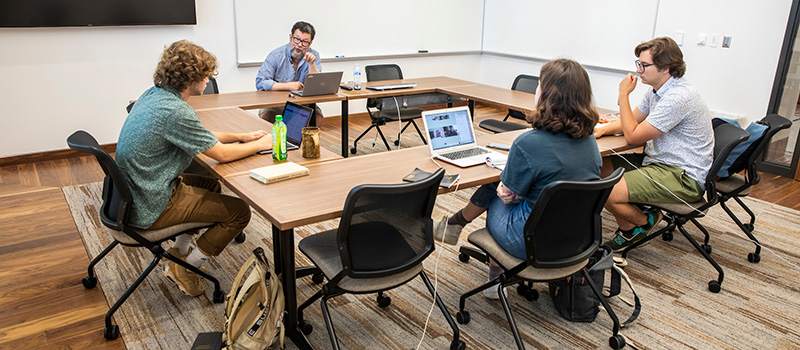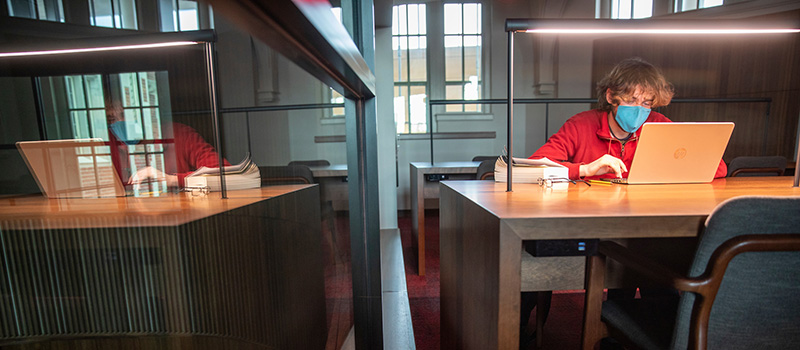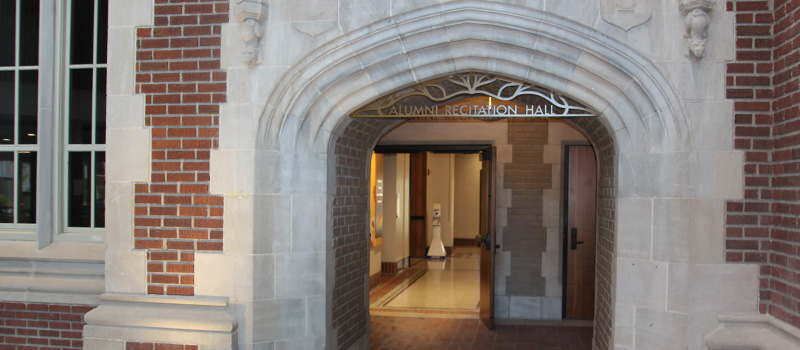Grinnellians enthusiastic about ARH, Carnegie renovations
November 18, 2021 — When Carnegie and Alumni Recitation Hall (ARH) were built in the early 20th century, both were at the forefront of modern design for their purposes.
A century later, Carnegie and ARH have new life as part of the Humanities and Social Studies Center (HSSC) and are now being used in academic and collaborative ways that weren’t possible before.
“It has been wonderful to see the renovated ARH and Carnegie open up for use,” says Erik Simpson, co-chair of the HSSC Planning Committee and the Samuel R. and Marie-Louise Rosenthal Professor of Humanities. “The renovations recapture a lot of what had been lost from the original buildings over the years, from the two-story auditorium in ARH to the ceiling of the original Carnegie library reading room. Now those spaces have new functions and new life as part of the HSSC, and it’s exciting to walk back and forth between the rejuvenated older buildings and the sunny, expansive modern additions.”
 Associate Professor of English Stephen Andrews, second from left, talks to students in a renovated Alumni Recitation Hall classroom.
Associate Professor of English Stephen Andrews, second from left, talks to students in a renovated Alumni Recitation Hall classroom.
After seven years of deliberations, design, and construction, the HSSC project was wrapped up in summer 2020 when the renovations to Carnegie Hall and ARH were completed. Since the 2020-21 academic year was primarily conducted online and access to campus buildings were limited, most students, staff, and faculty members did not have the opportunity to view the renovations until this fall.
It hasn’t taken long for the ARH to become a study area for students.
“One of the things I appreciate the most about the new ARH is the coziness and the aesthetic pleasantness of the study spaces, the fact that we have actual rooms to study, and chairs at the end of each hallway for individual study,” says Cát Đăng Tôn ’22. “The design is a lot nicer and more conducive to collaborative learning and meetings, or at least for study groups and for us to socialize.”
Dedicated on Nov. 24, 1916, the three-story Tudor-style building with Gothic features was part of a campus modernization effort prompted by rising enrollment. ARH has housed the College’s English, foreign languages, classics, psychology, education, history, economics, political science, and applied Christianity programs over the years. Now, it’s home to the philosophy, German, French & Arabic, and education departments.
The original auditorium on the second and third floors was regarded as the grandest feature of ARH. In the late 1980s, it was converted into a one-story auditorium on the third floor. Now it’s back on the second floor, with a reading room above it on the third. The ARH also houses three classrooms and numerous faculty offices.
 A student studies in the new Reading Room on the third floor of Alumni Recitation Hall.
A student studies in the new Reading Room on the third floor of Alumni Recitation Hall.
“I really like the space,” said Dustin Dixon, assistant classics professor about his office on the third floor of ARH. “I’m next to faculty that I wouldn’t be next to otherwise. I think that will lead to some interesting dynamics. I talk to people now from other departments that I haven’t spoken to regularly.”
“I find this side of the building dynamic,” he adds. “There’s lots of people around mixed in with the classrooms and study spaces. It’s a good buzz and energy. What’s great about this building is if I need to focus, there’s the reading room, which is a great space for quiet and focused work. Or you can go to Carnegie, which has much less traffic. The building is designed well to have collaborative energy but also the quiet study spaces.”
The west side exterior (visible from Park Street) of both ARH and Carnegie appear similar to how the buildings looked a century prior while the east side is merged skillfully with the sleek, modern design seen in the new HSSC atrium and pavilions. The project architect, EYP Inc., designed ARH and Carnegie (totaling 53,260 square feet, roughly the same size as before) to connect with the 147,539 square feet of new construction that opened in January 2019.
“I will admit I love that they decided to keep the old building,” William Holden Bulla ’22 says about ARH. “Integrating the old building and also letting it still be itself – versus just tearing it down and starting anew – is actually very nice. I like the ARH, and it’s nice that we don’t lose that space.”
Constructed in 1905, Carnegie served as the College’s library for more than a half century. In 1959, Carnegie was renovated to accommodate faculty offices, seminar rooms, mail service, and the College’s bookstore. The revamped present-day Carnegie has faculty offices, a combined Writing, Reading, and Speaking Center; study spaces; and a faculty and staff lounge. The Carnegie-ARH walkway connector, which was added in the 1980s, has been removed.
 An entrance to ARH from the HSSC atrium demonstrates how renovations of the existing buildings were merged with the new construction portions.
An entrance to ARH from the HSSC atrium demonstrates how renovations of the existing buildings were merged with the new construction portions.
While the College previously had separate writing and reading labs, the two are now under one roof at the west entrance to Carnegie. Professional instructors meet with students engaged in any writing, reading, or speaking project in any discipline. In addition to offices, the center has spaces for students to hang out with comfy chairs and tabletops.
“We’re hoping that the Writing, Reading, and Speaking Center will become a center of gravity for writing, and a place where students can do writing, think about writing, and be in community with writers instead of sort of that dentist waiting office feel where you come in and wait for your appointment and then go away again,” says Tisha Turk, director of the Writing, Reading, and Speaking Center. “Additionally, having space to collaborate among ourselves and with other offices on campus has really been terrific.”
While multi-disciplinary collaboration, active inquiry, and intellectual collisions – all key goals of the HSSC project – are already taking place, Simpson believes those areas will continue to expand.
“Our COVID protocols still limit the ways in which we can use the spaces together,” he says. “The HSSC is all about academic community, and it will be thrilling to be able to use its spaces fully, and fully together, in the coming years.”
— by Jeremy Shapiro
For your information:
HSSC interior and exterior investment opportunities are available at various gift levels. For more information, contact Susan Kriegel, development assistant, at 866-850-1846 or kriegels@grinnell.edu.
To read more alumni news, check out our news archive and like the Alumni & Friends Facebook page.